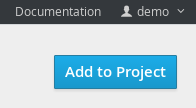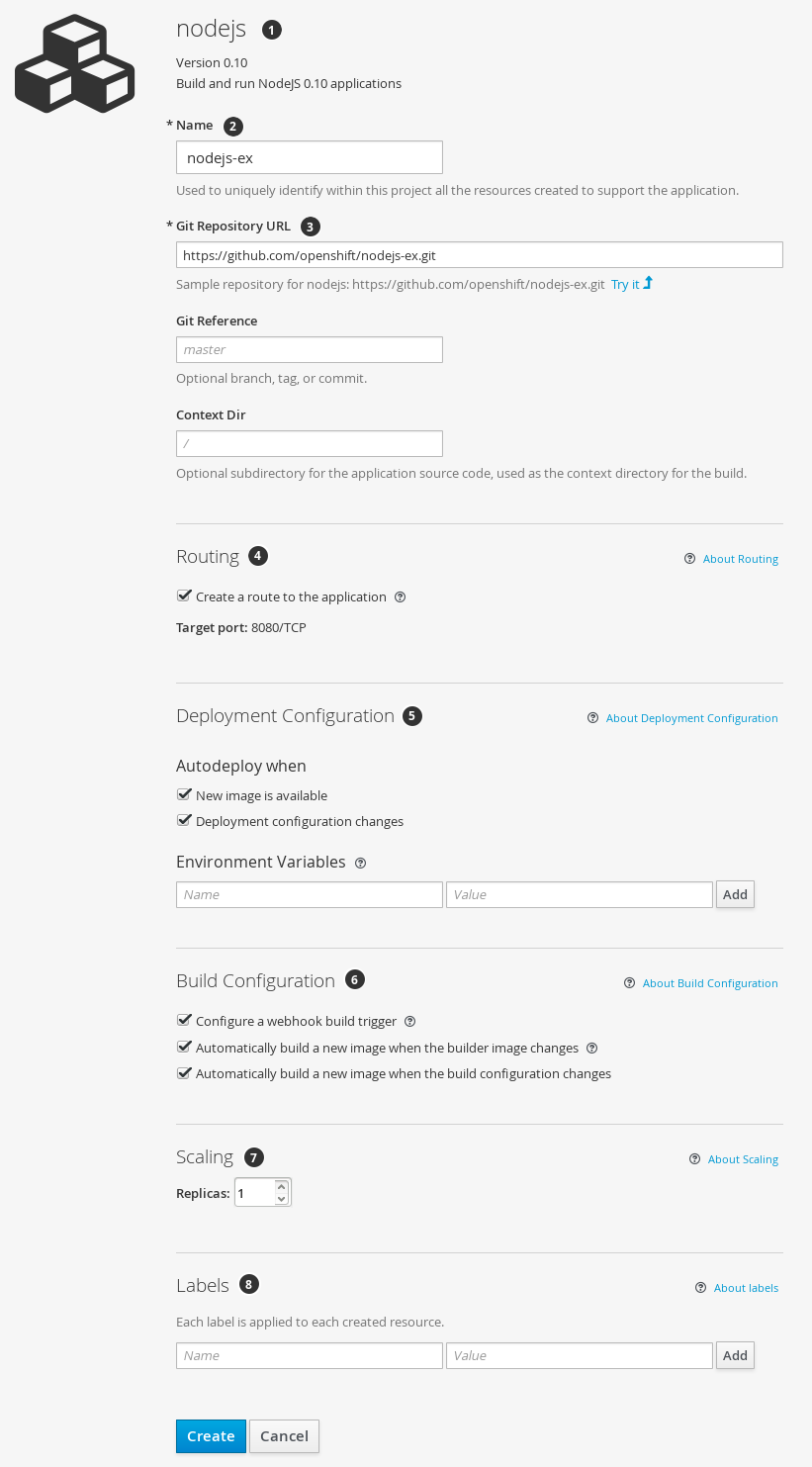This documentation is for a release that is no longer maintained
See documentation for the latest supported version 3 or the latest supported version 4.Chapter 5. Creating New Applications
5.1. Overview
You can create a new OpenShift Enterprise application from source code, images, or templates by using either the OpenShift CLI or web console.
5.2. Creating an Application Using the CLI
5.2.1. Creating an Application From Source Code
The new-app command allows you to create applications using source code in a local or remote Git repository.
To create an application using a Git repository in a local directory:
oc new-app /path/to/source/code
$ oc new-app /path/to/source/codeIf using a local Git repository, the repository must have an origin remote that points to a URL accessible by the OpenShift Enterprise cluster.
You can use a subdirectory of your source code repository by specifying a --context-dir flag. To create an application using a remote Git repository and a context subdirectory:
oc new-app https://github.com/openshift/sti-ruby.git \
--context-dir=2.0/test/puma-test-app
$ oc new-app https://github.com/openshift/sti-ruby.git \
--context-dir=2.0/test/puma-test-app
Also, when specifying a remote URL, you can specify a Git branch to use by appending #<branch_name> to the end of the URL:
oc new-app https://github.com/openshift/ruby-hello-world.git#beta4
$ oc new-app https://github.com/openshift/ruby-hello-world.git#beta4
Using new-app results in a build configuration, which creates a new application image from your source code. It also constructs a deployment configuration to deploy the new image, and a service to provide load-balanced access to the deployment running your image.
OpenShift Enterprise automatically detects whether the Docker or Sourcebuild strategy is being used, and in the case of Source builds, detects an appropriate language builder image.
Build Strategy Detection
If a Dockerfile is in the repository when creating a new application, OpenShift Enterprise generates a Docker build strategy. Otherwise, it generates a Source strategy.
You can specify a strategy by setting the --strategy flag to either source or docker.
oc new-app /home/user/code/myapp --strategy=docker
$ oc new-app /home/user/code/myapp --strategy=dockerLanguage Detection
If creating a Source build, new-app attempts to determine the language builder to use by the presence of certain files in the root of the repository:
| Language | Files |
|---|---|
|
| Rakefile, Gemfile, config.ru |
|
| pom.xml |
|
| app.json, package.json |
|
| index.php, composer.json |
|
| requirements.txt, setup.py |
|
| index.pl, cpanfile |
After a language is detected, new-app searches the OpenShift Enterprise server for image stream tags that have a supports annotation matching the detected language, or an image stream that matches the name of the detected language. If a match is not found, new-app searches the Docker Hub registry for an image that matches the detected language based on name.
You can override the image the builder uses for a particular source repository by specifying the image (either an image stream or container specification) and the repository, with a ~ as a separator.
For example, to use the myproject/my-ruby image stream with the source in a remote repository:
oc new-app myproject/my-ruby~https://github.com/openshift/ruby-hello-world.git
$ oc new-app myproject/my-ruby~https://github.com/openshift/ruby-hello-world.gitTo use the openshift/ruby-20-centos7:latest container image stream with the source in a local repository:
oc new-app openshift/ruby-20-centos7:latest~/home/user/code/my-ruby-app
$ oc new-app openshift/ruby-20-centos7:latest~/home/user/code/my-ruby-app5.2.2. Creating an Application From an Image
You can deploy an application from an existing image. Images can come from image streams in the OpenShift Enterprise server, images in a specific registry or Docker Hub registry, or images in the local Docker server.
The new-app command attempts to determine the type of image specified in the arguments passed to it. However, you can explicitly tell new-app whether the image is a Docker image (using the --docker-image argument) or an image stream (using the -i|--image argument).
If you specify an image from your local Docker repository, you must ensure that the same image is available to the OpenShift Enterprise cluster nodes.
For example, to create an application from the DockerHub MySQL image:
oc new-app mysql
$ oc new-app mysqlTo create an application using an image in a private registry, specify the full Docker image specification:
oc new-app myregistry:5000/example/myimage
$ oc new-app myregistry:5000/example/myimage
If the registry containing the image is not secured with SSL, cluster administrators must ensure that the Docker daemon on the OpenShift Enterprise node hosts is run with the --insecure-registry flag pointing to that registry. You must also tell new-app that the image comes from an insecure registry with the --insecure-registry=true flag.
You can create an application from an existing image stream and tag (optional) for the image stream:
oc new-app my-stream:v1
$ oc new-app my-stream:v15.2.3. Creating an Application From a Template
You can create an application from a previously stored template or from a template file, by specifying the name of the template as an argument. For example, you can store a sample application template and use it to create an application.
To create an application from a stored template:
oc create -f examples/sample-app/application-template-stibuild.json oc new-app ruby-helloworld-sample
$ oc create -f examples/sample-app/application-template-stibuild.json
$ oc new-app ruby-helloworld-sample
To directly use a template in your local file system, without first storing it in OpenShift Enterprise, use the -f|--file argument:
oc new-app -f examples/sample-app/application-template-stibuild.json
$ oc new-app -f examples/sample-app/application-template-stibuild.jsonTemplate Parameters
When creating an application based on a template, use the -p|--param argument to set parameter values defined by the template:
oc new-app ruby-helloworld-sample \
-p ADMIN_USERNAME=admin,ADMIN_PASSWORD=mypassword
$ oc new-app ruby-helloworld-sample \
-p ADMIN_USERNAME=admin,ADMIN_PASSWORD=mypassword5.2.4. Further Modifying Application Creation
The new-app command generates OpenShift Enterprise objects that will build, deploy, and run the application being created. Normally, these objects are created in the current project using names derived from the input source repositories or the input images. However, new-app allows you to modify this behavior.
The set of objects created by new-app depends on the artifacts passed as input: source repositories, images, or templates.
| Object | Description |
|---|---|
|
|
A |
|
|
For |
|
|
A |
|
|
The |
| Other | Other objects can be generated when instantiating templates. |
5.2.4.1. Specifying Environment Variables
When generating applications from a source or an image, you can use the -e|--env argument to pass environment variables to the application container at run time:
oc new-app openshift/postgresql-92-centos7 \
-e POSTGRESQL_USER=user \
-e POSTGRESQL_DATABASE=db \
-e POSTGRESQL_PASSWORD=password
$ oc new-app openshift/postgresql-92-centos7 \
-e POSTGRESQL_USER=user \
-e POSTGRESQL_DATABASE=db \
-e POSTGRESQL_PASSWORD=password5.2.4.2. Specifying Labels
When generating applications from source, images, or templates, you can use the -l|--label argument to add labels to the created objects. Labels make it easy to collectively select, configure, and delete objects associated with the application.
oc new-app https://github.com/openshift/ruby-hello-world -l name=hello-world
$ oc new-app https://github.com/openshift/ruby-hello-world -l name=hello-world5.2.4.3. Viewing the Output Without Creation
To see a dry-run of what new-app will create, you can use the -o|--output argument with a yaml or json value. You can then use the output to preview the objects that will be created, or redirect it to a file that you can edit. Once you are satisfied, you can use oc create to create the OpenShift Enterprise objects.
To output new-app artifacts to a file, edit them, then create them:
oc new-app https://github.com/openshift/ruby-hello-world \
-o yaml > myapp.yaml
vi myapp.yaml
oc create -f myapp.yaml
$ oc new-app https://github.com/openshift/ruby-hello-world \
-o yaml > myapp.yaml
$ vi myapp.yaml
$ oc create -f myapp.yaml5.2.4.4. Creating Objects With Different Names
Objects created by new-app are normally named after the source repository, or the image used to generate them. You can set the name of the objects produced by adding a --name flag to the command:
oc new-app https://github.com/openshift/ruby-hello-world --name=myapp
$ oc new-app https://github.com/openshift/ruby-hello-world --name=myapp5.2.4.5. Creating Objects in a Different Project
Normally, new-app creates objects in the current project. However, you can create objects in a different project that you have access to using the -n|--namespace argument:
oc new-app https://github.com/openshift/ruby-hello-world -n myproject
$ oc new-app https://github.com/openshift/ruby-hello-world -n myproject5.2.4.6. Creating Multiple Objects
The new-app command allows creating multiple applications specifying multiple parameters to new-app. Labels specified in the command line apply to all objects created by the single command. Environment variables apply to all components created from source or images.
To create an application from a source repository and a Docker Hub image:
oc new-app https://github.com/openshift/ruby-hello-world mysql
$ oc new-app https://github.com/openshift/ruby-hello-world mysql
If a source code repository and a builder image are specified as separate arguments, new-app uses the builder image as the builder for the source code repository. If this is not the intent, simply specify a specific builder image for the source using the ~ separator.
5.2.4.7. Grouping Images and Source in a Single Pod
The new-app command allows deploying multiple images together in a single pod. In order to specify which images to group together, use the + separator. The --group command line argument can also be used to specify the images that should be grouped together. To group the image built from a source repository with other images, specify its builder image in the group:
oc new-app ruby+mysql
$ oc new-app ruby+mysqlTo deploy an image built from source and an external image together:
oc new-app \
ruby~https://github.com/openshift/ruby-hello-world \
mysql \
--group=ruby+mysql
$ oc new-app \
ruby~https://github.com/openshift/ruby-hello-world \
mysql \
--group=ruby+mysql5.2.4.8. Useful Edits
Following are some specific examples of useful edits to make in the myapp.yaml file.
These examples presume myapp.yaml was created as a result of the oc new-app … -o yaml command.
Example 5.1. Deploy to Selected Nodes
- 1
- In myapp.yaml, the section that defines the myapp project has both
kind: Projectandmetadata.name: myapp. If this section is missing, you should add it at the second level, as a new item of the listitems, peer to thekind: ImageStreamdefinitions. - 2
- Add this node selector annotation to the myapp project to cause its pods to be deployed only on nodes that have the label
region=west.
5.3. Creating an Application Using the Web Console
While in the desired project, click Add to Project:
Select either a builder image from the list of images in your project, or from the global library:
NoteOnly image stream tags that have the builder tag listed in their annotations appear in this list, as demonstrated here:
Copy to Clipboard Copied! Toggle word wrap Toggle overflow - 1
- Including builder here ensures this
ImageStreamTagappears in the web console as a builder.
Modify the settings in the new application screen to configure the objects to support your application:
- The builder image name and description.
- The application name used for the generated OpenShift Enterprise objects.
- The Git repository URL, reference, and context directory for your source code.
- Routing configuration section for making this application publicly accessible.
- Deployment configuration section for customizing deployment triggers and image environment variables.
- Build configuration section for customizing build triggers.
- Replica scaling section for configuring the number of running instances of the application.
- The labels to assign to all items generated for the application. You can add and edit labels for all objects here.
NoteTo see all of the configuration options, click the "Show advanced build and deployment options" link.


